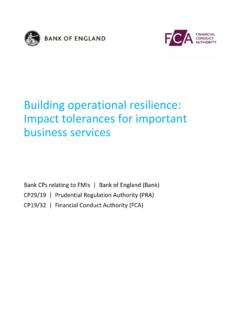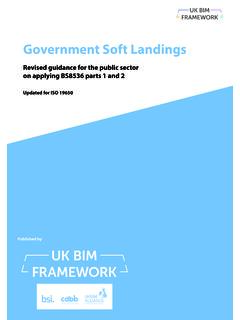Transcription of 2022/23 priorities and operational planning guidance
1 Classification: Official Publication approval reference: PAR1160. 2022/23 priorities and operational planning guidance Version 3, 22 February 2022. updates from previous versions are highlighted throughout the document Version Number Date Details of change V1 24 December 2021 Initial version V2 14 January 2022 Page 22 under community care models, a sentence about those living with frailty has been amended. The change is highlighted. Page 22 community care models- information about virtual wards has been amended to read 40-50 virtual beds per 100,000 population. The change is highlighted.
2 Page 29, a date has been corrected and the change is highlighted. V3 22 February 2022 Page 13 Elective care ambitions updated to reflect the Delivery plan for tackling the Covid-19 backlog of elective care' (Feb 2022). Three changes are highlighted. Page 21 NHS111 clinical capacity within the clinical assessment service has been amended to read >50% of calls received having clinical input. The change is highlighted. 2 | 2022/23 priorities and operational planning guidance Dear colleague Thank you to you and your teams for your continued extraordinary efforts for all our patients.
3 At the end of January, we will mark two years since paramedics from Yorkshire Ambulance Service and hospital teams in Hull and Newcastle started to treat this country's first patients with COVID-19, and earlier this month we marked the anniversary of the first COVID-19 vaccine dose and the milestone of 100 million doses delivered in the biggest and fastest vaccination programme in NHS history. The last two years have been the most challenging in the history of the NHS, and staff across the service and many thousands of volunteers have stepped up time and time again: expanding and flexing services to meet the changing demands of the pandemic developing and rolling out new treatments, new services and new pathways to respond to the needs of patients with COVID-19 and those without pulling out all the stops to recover services that have been disrupted.
4 At the time of writing, we are again operating within a Level 4 National Incident in response to the emergence of the Omicron variant. Teams from across the NHS and our partners are: significantly increasing vaccination capacity to provide the maximum level of immunity for the maximum number of people rolling out new antiviral and monoclonal antibody treatments through COVID. medicines delivery units preparing for a potentially significant increase in those requiring life-saving care. This concrete and rapid action in the face of uncertainty has characterised the NHS.
5 Response to the pandemic. We face that uncertainty again now in terms of the potential impact of Omicron over the coming weeks and months and the development of the pandemic as we look ahead to 2022/23 . Despite this, the clear message I have had from colleagues across the NHS is that it is important to provide certainty and clarity where we can by now setting out the priorities and financial arrangements for the whole of 2022/23 , recognising that they will have to be kept under review. 3 | 2022/23 priorities and operational planning guidance The objectives set out in this document are based on a scenario where COVID-19.
6 Returns to a low level and we are able to make significant progress in the first part of next year as we continue to rise to the challenge of restoring services and reducing the COVID backlogs. Building on the excellent progress seen during 2021/22, this means significantly increasing the number of people we can diagnose, treat and care for in a timely way. This will depend on us doing things differently, accelerating partnership working through integrated care systems (ICSs) to make the most effective use of the resources available to us across health and social care, and ensure reducing inequalities in access is embedded in our approach .
7 As part of this, and when the context allows it, we will need to find ways to eliminate the loss in non-COVID output caused by the pandemic. Securing a sustainable recovery will depend on a continued focus on the health, wellbeing and safety of our staff. ICSs will also need to look beyond the immediate operational priorities and drive the shift to managing the health of populations by targeting interventions at those groups most at risk and focusing on prevention as well as treatment. Thank you for the significant progress that has been made in preparing for the proposed establishment of statutory Integrated Care Systems.
8 To allow sufficient time for the remaining parliamentary stages, a new target date of 1 July 2022. has been agreed for statutory arrangements to take effect and ICBs to be legally and operationally established. Our ability to fully realise the objectives set out in this document is linked to the ongoing level of healthcare demand from COVID-19. Given the immediate priorities and anticipated pressures, we are not expecting you or your teams to engage with specific planning asks now. The planning timetable will be extended to the end of April 2022, and we will keep this under review.
9 On behalf of myself and the whole NHS leadership team I want to thank you for the way you are continuing to support staff, put patients first and rise to the challenges we face. With best wishes Amanda Pritchard NHS Chief Executive 4 | 2022/23 priorities and operational planning guidance Introduction In 2022/23 we will continue to rise to the challenges of restoring services, meeting the new care demands and reducing the care backlogs that are a direct consequence of the pandemic. While the future pattern of COVID-19 transmission and the resulting demands on the NHS remain uncertain, we know we need to continue to increase our capacity and resilience to deliver safe, high quality services that meet the full range of people's health and care needs.
10 We will: accelerate plans to grow the substantive workforce and work differently as we keep our focus on the health, wellbeing and safety of our staff use what we have learnt through the pandemic to rapidly and consistently adopt new models of care that exploit the full potential of digital technologies work in partnership as systems to make the most effective use of the resources available to us across acute, community, primary and social care settings, to get above pre-pandemic levels of productivity as the context allows use the additional funding government has made available to us to increase our capacity and invest in our buildings and equipment to support staff to deliver safe, effective and efficient care.


















